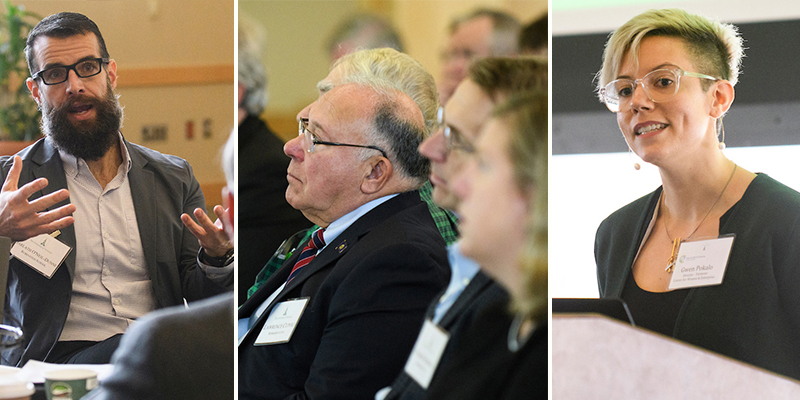Last week the Silver Maple Ballroom in the Davis Center was again a home away from home for Vermont state legislators as UVM hosted its sixth annual Legislative Summit.
About 50 members of the Vermont House of Representatives and Senate made the trek to campus on Wednesday to hear presentations by and engage in conversations with 16 UVM faculty, students and alumni. The event began at 8:30 and adjourned after lunch.
“The goal of these summits is to increase interaction between UVM researchers and scholars and state legislators so policy makers have access to our faculty’s expertise as they address complex issues in the legislation they’re drafting,” said Richard Galbraith, UVM’s vice president for research. “Over the years, legislators have told us the summit does a good job of helping make these important connections, and I thought this year’s edition was no exception.”
Past summits have focused on issues ranging from water quality to climate change to healthcare.
The topic of this year’s summit was rural economic development, a key issue for a state where 75 percent of the population lives in rural areas and one that is becoming increasingly urgent.
“We’re seeing a generational shift throughout rural America, and the consequences for Vermont are significant,” said Brattleboro representative and UVM board member Tristan Toleno, a key legislative liaison for the summit.
From a public policy perspective the question has always been, “How do we become informed enough to be sure that the policies we’re writing for the whole state are meaningfully affecting the kinds of challenges that rural communities are going through?” Toleno said as the summit was getting underway,
By the summit’s end, Toleno thought good progress had been made.
“In a half-day conference covering a complex topic, the goal is not to become masters of the universe,” he said. “But I think we opened up a wider conversation about the future of Vermont and what sustainability in our rural communities looks like. I saw some intellectual fires burning around the room today, and that’s what I was hoping for.”
The summit had three key elements, said Jane Kolodinsky, chair of the Community Development and Applied Economics Department, who took the lead in recruiting faculty and staff participants and in organizing the day in partnership with legislators, Galbraith, Wendy Koenig, UVM’s director of federal and state relations, and Tom Vogelmann, dean of the College of Agriculture and Life Sciences.
“First you have to know what you need to measure, so we began with a metrics theme,” she said, with presentations from a panel of four UVM faculty and staff, Michael Moser, Jon Erickson, Jarlath O’Neil-Dunne and Cheryl Morse.
“Then we wanted legislators to know what UVM faculty are doing” in rural community development and what the success stories are. Five faculty, including Kelly Hamshaw, Rocki-Lee Dewitt, Kolodinsky, and, jointly, Heather Darby and Steve Kostell, presented during that section of the morning.
The final section asked the question, “What is the future and how will UVM be contributing to economic development then?” she said.
Perhaps the most significant way will be as “educators of the economic developers of the future,” Kolodinsky said, so the day concluded with a “panel of current and former students who are actually here working on community economic development in the state.” They included Jared Alvord, Chris Dubin, Ryan McDevitt, Gwen Pokalo, Alexander Marchese, Grayson Glosser, Jaen Carrodine and Alyssa Johnson.
Each of the three sections began with presentations by panel members. Then the panelists repaired to one of several roundtables for concurrent Q&A sessions with legislators.
Legislative praise for the summit crossed the aisle.
“I’ve attended many of these symposiums, it’s really wonderful to be here,” said Larry Cupuli, Republican representative from Rutland City and a member of the House Committee on Education. “I’m here to pick up a few good ideas, and I’ve already done that,” he said midmorning.
“UVM is an incredible resource, not just as a learning institution but in the access we have to the research that’s going on here,” said Kate Webb, a Democratic representative from Shelburne who is also a member of the Committee on Education.
“I’ve come every year and I always appreciate what I learn. The topics are relevant to what’s going on and address the questions we’re going to be facing in the legislature.”
Webb was particularly enthusiastic about the panel of UVM current students and alumni that concluded the session.
“It’s inspiring,” she said. “We hear so much about the problems of today’s students, today’s youth, the next generation. It’s just really inspiring to hear the other side of what’s going on.”
UVM faculty were as keen to share information about their work as legislators were to receive it.
“It’s critically important,” said Geography professor Cheryl Morse, whose presentation focused on in- and out-migration of youth in the state. “We are a land-grant institution. It’s our job to be talking with the people who are tracking policy to help inform them, but also to co-create with them.
“They were really receptive, really curious, and they wanted to soak in as much as they could.”
Koldinsky agreed.
“We wanted to give legislators a chance to actually discuss these issues,” she said. “There was plenty of discussion, and it went way beyond the lunchtime allotted for the event. There was lots of … Yes we will follow up … We didn’t know you did that … This is great … We need more of this. There was no dearth of conversation.”
Source: UVM News

